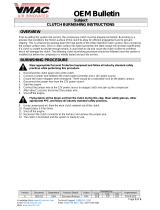
ST Electric Shoe Brakes Instruction Manual
October 2018
Page 3 of 52
Table of Contents
1 General Description............................................................................................................................7
1.1 ST.................................................................................................................................................8
1.2 ST/E .............................................................................................................................................9
2 Application ........................................................................................................................................10
3 Description of Operation.................................................................................................................. 11
3.1 General.......................................................................................................................................11
3.2 Thruster Reserve Stroke ............................................................................................................14
3.3 Pushrods ....................................................................................................................................16
3.4 Automatic Adjustment Pushrod Assembly ................................................................................. 17
3.5 Manual Adjustment Pushrod Assembly......................................................................................18
3.6 Automatic Equalization Assembly ..............................................................................................18
3.7 External Torque Spring Assembly..............................................................................................19
3.8 Hand-Release Mechanism .........................................................................................................20
3.9 Limit Switches ............................................................................................................................22
3.10 Other .........................................................................................................................................23
4 Adjustment ........................................................................................................................................ 24
4.1 Manual Operation.......................................................................................................................25
4.2 Automatic Adjustment Pushrod ..................................................................................................25
4.3 Manual Adjustment (MA) Pushrod .............................................................................................27
4.4 Torque Adjustment .....................................................................................................................28
4.5 Automatic Equalization (AE) Assembly ......................................................................................29
4.6 Anti-Drag Feature....................................................................................................................... 30
4.7 Time Delay Adjustment ..............................................................................................................31
5 Electrical Detail ................................................................................................................................. 32
6 Installation.........................................................................................................................................34
7 Burnishing.........................................................................................................................................40
8 Operational Test ...............................................................................................................................42
9 Maintenance and Repair ..................................................................................................................44
9.1 Replacing the Brake Shoes........................................................................................................44
9.2 Pushrods ....................................................................................................................................47
9.3 Bushings for AA and XTS Assemblies .......................................................................................47
9.4 Other ..........................................................................................................................................47
9.5 Inspection ...................................................................................................................................47
9.6 Lubrication..................................................................................................................................48
9.7 Thruster Working Fluid ...............................................................................................................49
10 Replacement Parts ...........................................................................................................................50
10.1 Brake Lining Replacement ........................................................................................................50
11 Long-Term Storage...........................................................................................................................51
CE Declaration of Incorporation .............................................................................................................52

































